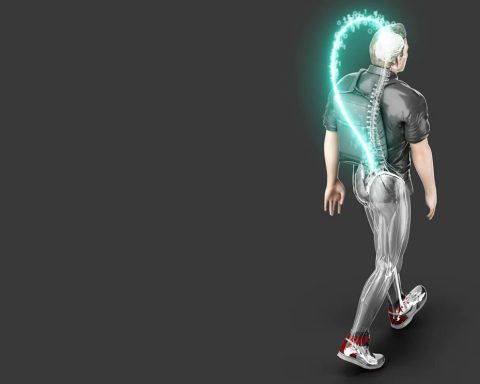The experiment was conducted on the brains of frogs. Even tadpoles, to be precise. It consisted of exposing embryos of the species... Xenopus laevis to a mixture of chemicals comparable to that found in the amniotic fluid of most pregnant women. The best known of these is bisphenol A, which is now found, for example, in the sales receipts. The result, published on 7 March in the newspaper Scientific Reportsshows that the neurons in these tadpoles are smaller.
Rs in our laboratory at the Museum of Natural HistoryIn Paris, this experiment could seem far removed from our concerns as humans, we who look so little like batrachians. But contrary to appearances, we have an important point in common: the hormone produced by the thyroid, the neck gland located above the sternum. The thyroid hormone is identical, to the nearest atom, in humans, frogs, sharks, birds and mice. And it plays a key role in brain development.
For example, our work provides scientific evidence that when substances interfere with thyroid hormone in tadpoles, they also pose a threat to human intelligence.

A specimen of the frog Xenopus laevis. PLOS Biology 2011/wikimedia
By what reasoning did our team design this experience, and for what purpose exactly? There are several worrying signs of adverse effects on the brain around the world today. The progression of Autism Spectrum Disorders (ASD), for starters. In the United States, they affect one in 42 boys, with a marked increase in incidence since the early 2000s. This phenomenon coincides with an increase in another neurodevelopmental disorder, attention deficit hyperactivity disorder (ADHD). Genetic factors and the broadening of diagnostic criteria for ASD and ADHD only partially explain the progression. The impact of environmental factors, which in many cases likely exacerbate genetic predispositions, must be examined.
A drop in IQs around the world
At the same time, there has been a significant decline in IQs in several populations that researchers have been following for a long time, such as Finnish conscriptsBritish schoolchildren or of French adults. The regular publication of data from these different countries is proof of this.
Many scientists are now looking for explanations for these changes in people's early life exposure to chemicals in general, and to "endocrine disruptors" in particular. The term refers to synthetic molecules that can interfere with our endocrine system, i.e. blurring the message of hormones travelling through the bloodstream to control the body's functioning.
As the fetus becomes a child and then an adolescent, hormones send key signals that contribute to the proper development of its brain. Thyroid hormone is one of the most important ones to play this role.
Without thyroid hormone, the child becomes a "moron."
If this hormone is not secreted at the right time - especially in the perinatal period, before and after birth - the child becomes a "moron" in the medical sense. Few people have heard of the pathology behind this term, which is commonly used as an insult. Cretinism is characterized by severe mental retardation, with an IQ of less than 35 - with most people between 85 and 115. Only a few elderly people remember having been around people suffering from this terrible disease, the causes of which have been known for more than a century. Today, we make sure that every newborn baby is getting or secreting enough thyroid hormone.
It is not uncommon to hear that the human brain is the most complex structure sculpted by evolution. Indeed, it has taken 450 million years since vertebrates - cartilaginous fish such as sharks and rays - first appeared to arrive at humans with their unique reasoning abilities. And from the first vertebrates, thyroid hormone - still it! - already played a major role in several brain-forming processes.
To mention just one, let's mention myelination, the formation of a layer of lipids around the nerves which, like a sheath on an electric wire, accelerates the transmission of the nerve signal. The thyroid gland and myelination appeared simultaneously in the evolution of vertebrates. And it is important to know that the thyroid hormone has not changed its structure one iota over these 450 million years. It has remained the same in humans... and in frogs.
Chemicals in the amniotic fluid
Thyroid hormone-induced signalling is the most vulnerable of all to chemicals in the environment. This is of particular concern for three reasons. Firstly, global production by the chemical industry has increased 300-fold in volume since 1970, according to the United Nations Environment Fund. From pesticidesPlasticizers, plasticizers and other products are found in significant quantities in the bodies of most children around the world. And in pregnant women's bodies. A large proportion of these molecules pass the placenta barrier, are found in the amniotic fluid and can therefore interfere, in the foetus, with the action of thyroid hormones.
Second, thestudy by a Dutch team published in 2016 has shown that maternal thyroid hormone levels during the first three months of pregnancy affect the IQ of the unborn child. Not enough hormones, or too many hormones, also have harmful effects, underlining the importance of having the right amount of hormones at the right time. These levels even act on the structure of the brain, reducing the amount of grey matter - the neurons - in favour of white matter - the supporting tissue of the neurons.
There is a third area of concern. An American team observed that children born to mothers who are highly exposed to chemicals such as PCBs (an oily liquid long used in electrical transformers), which are known to interfere with the action of thyroid hormones, lose on average 6 IQ points compared to children born to mothers with low exposure.
A "cocktail" effect that is anything but festive
Today, we are all contaminated by a mixture of chemicals producing a "cocktail" effect which, contrary to what its name suggests, is not festive. Already, the effects on the organism of each molecule taken in isolation have generally been little evaluated. So when it comes to the effects produced by their interactions... the problem is even more complex.
This is why biologist Jean-Baptiste Fini and I, along with students from our team specializing in the evolution of endocrine regulation, designed the experiment involving tadpoles.
The "cocktail" to which we have exposed these future frogs consists of 15 chemicals common in our daily lives, including bisphenol A, triclosan, benzophenone-3 and sodium perchlorate, at concentrations frequently measured in human amniotic fluid.
The tadpoles were exposed for only three days to this mixture. We showed that this affected not only the functioning of the thyroid hormones but also the expression of several genes in their brains. In the end, this exposure reduced the volume of their neurons and inhibited their movements.
The urgency of a regulatory review
These results suggest that exposure to these common chemicals can harm brain development in human fetuses. They plead for an urgent review of their regulations.
In conclusion, an ironic observation. Pregnant women are advised not to take any medication unless absolutely necessary. Yet every pregnant woman, whether in the city or in the country, regardless of her lifestyle, is exposed to hundreds of chemicals on a daily basis, without being able to do anything about it. What are we waiting for ?
Barbara Demeneix, Professor of endocrinology, National Museum of Natural History (MNHN) - Sorbonne University
The original text of this article was published on The Conversation.












